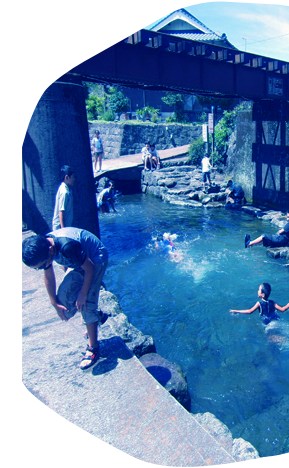
Global Groundwater Reserves
The total amount of water on Earth is approximately 1.4 billion km3, of which seawater, including salty groundwater, accounts for about 97.5% and covers more than two-thirds of the surface area of the Earth. The remainder, a mere 2.5%, is fresh water, most of which is solid in the form of ice in Antarctica and as snow on mountaintops. Liquid fresh water, e.g., river water, lake water, and groundwater, accounts for a paltry 0.8%. Most of this liquid fresh water is groundwater. Other water, such as river water, accounts for an even smaller amount: about 0.01% (Figure 1).
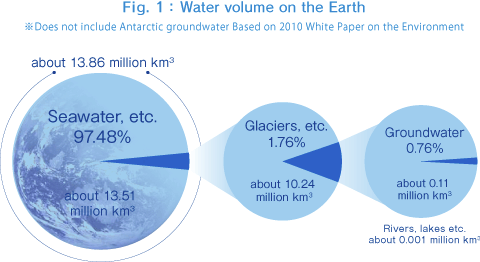
Confined Groundwater and Unconfined Groundwater
Geological strata can be classified into either aquifers, impermeable layers, or low-permeability layers based on how freely water is able to flow through them (see Figure 2).
- Aquifer:
- An aquifer is a geological stratum that has high water permeability and retains a large quantity of groundwater that exhibits high mobility within the aquifer. It is commonly composed of sedimentary layers such as a gravel beds and fissured bedrock.
- Impermeable layer:
- An impermeable layer is a geological stratum in which the mobility of groundwater is negligibly small compared to an aquifer. It is commonly composed of bedrock or fine-grain clay and forms the base of an aquifer.
- Low-permeability layer:
- A low-permeability layer is comprised of silt, sandy clay, etc., and possesses properties somewhere in between an aquifer and an impermeable layer. When aquifers lie immediately above and below a low-permeability layer, groundwater from within this low-permeability layer can be squeezed out if the water supply of the neighboring aquifer is rapidly depleted through pumping. This causes the low-permeability layer to contract, which can then cause the ground to sink, a phenomenon called “ground subsidence.”
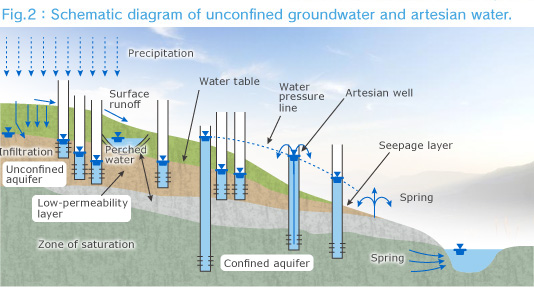
Hydrogeological structures that yield confined groundwater and unconfined groundwater are as follows:
- Confining layer:
- A low-permeability layer that creates pressure on groundwater in an underlying aquifer, thereby confining the aquifer.
- Confined groundwater:
- The properties of groundwater vary greatly depending on whether a confining layer exists above an aquifer or not. Aquifers that are pressurized by a confining layer are designated as confined aquifers. Groundwater within a confined aquifer is called confined groundwater.
- Unconfined groundwater:
- Aquifers having no confining layer on top and containing groundwater that is not under pressure are called unconfined aquifers, and groundwater within such unconfined aquifers is referred to as unconfined groundwater. Unconfined groundwater has a groundwater table that fluctuates freely in response to pumping or ground surface recharge. This is in contrast to confined groundwater, which lacks a free water table because the top face of the aquifer is closed off by a confining layer.
Nevertheless, in a strainer-equipped well tapping a confined aquifer, the water level in the well hole will rise above the level of the bottom of the confining later due to the pressure on the groundwater (see the water pressure equilibrium line in Figure 2). The potential level to which pressurized groundwater would flow out on its own accord is called the potentiometric surface. Confined groundwater will naturally gush out of a well if this potentiometric surface is higher than the ground surface. Such an aquifer is called a “flowing artesian” aquifer.
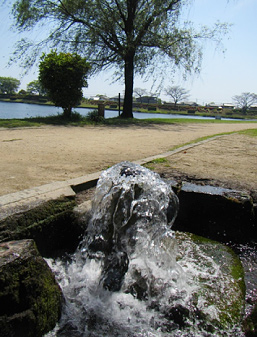
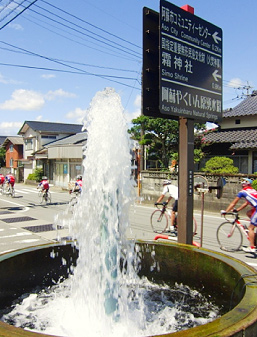
- Perched water:
- Small-scale bodies of groundwater lying on top of discontinuously distributed low-permeability or impermeable layers (such as clay) are referred to as perched water. With perched water, groundwater may naturally flow out initially when a well is dug but dry up shortly thereafter.
Works Cited ...
Japan Association of Groundwater Hydrology/Ida (2009): “Me-ni Mienai Kyodai Suimyaku Chikasui-no Kagaku” Kodansha, 267p.
Arai & Sakura (1980): Saikin-no Egawa-no Ijo Suion-ni Tsuite. Hydrology, 10, 397-407.
Arai & Yokohata (1990): Tokushima-ken Egawa Fukin-no Chikasui-no Ondo to Ryudo. Chirigaku Hyoron., 63 (A), 343-355.
Shimano & Nagai (1995): Nihon-sui Kiko (9), Shikoku Chiho-no Meisui. Chishitsu News, 486, 45-55.
Shimada J. (1988): The mechanism of unsaturated flow through a volcanic ash layer under humid climatic conditions. Hydrological Processes, 2, 43-59.
Kayane, Tanaka & Shimada (1980): Kanko Tritium de Tsuiseki-shita Kanto Loam-sochu-no Dojosui-no Ido. Chirigaku Hyoron, 53, 225-237.
Japan Association of Groundwater Hydrology (ed.) (2001): “21-seiki-no Chikasui Kanri Amamizu Shinto/Chikasui Kanyo” Riko Tosho, 160p.
Wood & Sanford (1995):Chemical and isotopic methods for quantifying groundwater recharge in a regional, semi-arid environment. Groundwater, 33, 458-468.



